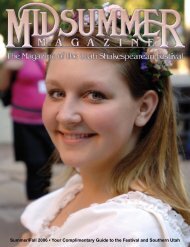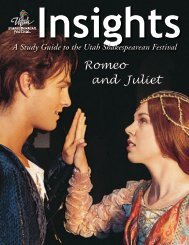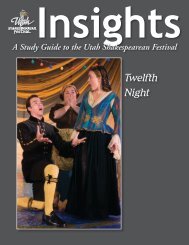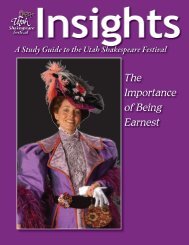The Tempest - Utah Shakespearean Festival
The Tempest - Utah Shakespearean Festival
The Tempest - Utah Shakespearean Festival
Create successful ePaper yourself
Turn your PDF publications into a flip-book with our unique Google optimized e-Paper software.
28<br />
<strong>The</strong> <strong>Tempest</strong>:<br />
Physical and Emotional Storms<br />
By Michael Flachmann<br />
From Insights, 1995<br />
Shakespeare’s <strong>The</strong> <strong>Tempest</strong> (1611), like so many of his later plays, features an intense storm scene,<br />
which profoundly restructures the plot and characters within their dramatic universe. Through his<br />
“so potent art” (5.1.50), Prospero causes a shipwreck at the outset of the action, marooning on<br />
his island not only his two most bitter enemies, but also the future husband of his beloved daughter,<br />
Miranda. Suspended between his lust for revenge and his need for regeneration and renewal,<br />
Shakespeare’s magician-hero forgives his adversaries, bestows his daughter upon the future king of<br />
Naples, and then abjures his “art” by breaking his magic staff and drowning his book of charms<br />
“deeper than did ever plummet sound” (5.1.56).<br />
Not surprisingly for a play so devoted to tempests both physical and emotional, Shakespeare’s<br />
comedy has elicited a storm of controversy from a number of different sources during the past four<br />
centuries. Even the long-accepted conventional interpretation of the play as Shakespeare’s farewell to<br />
the stage, complete with Prospero as playwright renouncing his theatrical magic, has recently come<br />
under close scrutiny by bibliographers who believe the script was written before Henry VIII and <strong>The</strong><br />
Two Noble Kinsmen and may even have preceded <strong>The</strong> Winter’s Tale. So much for dramatic tradition!<br />
Five areas of disagreement that offer particular fascination to modern readers and theatergoers<br />
include characterization, colonization, images of the new world, magic, and the masque. Through<br />
his soaring poetry, Shakespeare dramatizes the inherent conflicts within each of these categories,<br />
organizing his play around a series of debates that are as intriguing today as they were nearly four<br />
hundred years ago. Since <strong>The</strong> <strong>Tempest</strong> is a theatrical “script,” however, it can only be completely realized<br />
through performance. Solely in that artistic venue can the infinity of choices available to readers<br />
of the play be narrowed and refined to a single production, unique to the particular place, time, and<br />
audience of the <strong>Utah</strong> <strong>Shakespearean</strong> <strong>Festival</strong> during the summer of 1995 in Cedar City.<br />
This wide range of interpretive possibilities is nowhere more startling than in the contrast<br />
between such characters as Prospero and his “abhorred slave” (1.2.351) Caliban. Prospero, for example,<br />
has been identified variously in recent theatrical productions and in scholarly books and articles<br />
as a noble ruler, tyrant, necromancer, neoplatonic scientist, imperialist, and magician, while portrayals<br />
of Caliban have ranged from ugly, deformed savage to sensitive, victimized new-world native.<br />
<strong>The</strong> precise degree of interpretation of these and such other seminal characters as Ariel, Miranda,<br />
Ferdinand, Antonio, Alonzo, and Gonzalo will depend, of course, upon the director, design team,<br />
and individual actors at the <strong>Festival</strong> this summer, since they will make all the necessary decisions that<br />
must transform the play from “page” to “stage.”<br />
Likewise, any good theatrical performance of the script must on some level respond to the charge<br />
that Prospero has stolen the island from its original inhabitants in the same manner that Renaissance<br />
England was slowly beginning to colonize much of the civilized world. Caliban, whose name is an<br />
anagram of “cannibal,” had previously “owned” the island with his dam, Sycorax, and had his power<br />
and authority over the territory usurped in much the same way Antonio had stolen Prospero’s dukedom<br />
in Milan. As the great popularity of Montaigne’s essay “Of the Cannibals” (translated into<br />
English by John Florio in 1603) indicates, the colonization of relatively unspoiled lands where prelapsarian<br />
natives led an Edenic existence had become a wildly controversial topic by the later stages<br />
of Shakespeare’s career. What were the proper moral and ethical responsibilities of colonial exploration?<br />
And what obligation, if any, did the invaders have in educating and Christianizing the primitive<br />
inhabitants they found during their travels? Perhaps, the play seems to suggest ironically, it is<br />
the Europeans who are savage, predatory, and inhuman in their enslavement of indigenous citizens<br />
<strong>Utah</strong> <strong>Shakespearean</strong> <strong>Festival</strong><br />
351 West Center Street • Cedar City, <strong>Utah</strong> 84720 • 435-586-7880

















